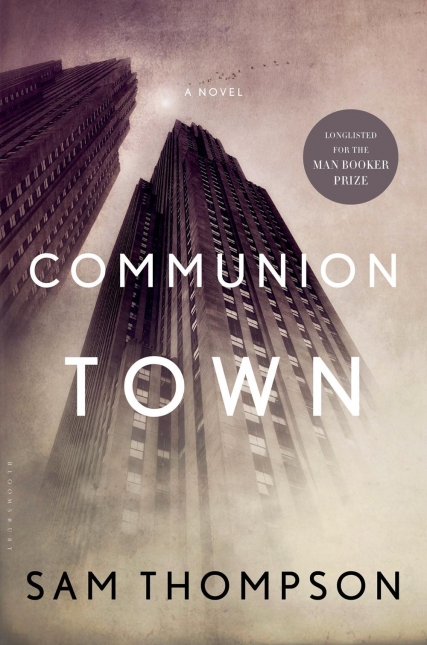Communion Town: A Novel
- By Sam Thompson
- Bloomsbury
- 288 pp.
- Reviewed by Liam Callanan
- December 5, 2013
A city is brought to vivid life through a fractal depiction of its inhabitants.

The novel isn’t dead, but perhaps calling books novels that aren’t should be. Sam Thompson’s fitfully fascinating Communion Town was originally published in the UK as Communion Town: A City in Ten Chapters, an invitingly strange subtitle that clearly caught the fancy of many: it was among the 12 books on the 2012 Man Booker Prize Longlist. (Man Booker trivia buffs may know that Hilary Mantel’s Bring Up the Bodies eventually won the prize, but perhaps not that one of the judges that year was Dan Stevens, better known as “cousin Matthew” on Downtown Abbey, who had a special e-reader pocket sewn into his otherwise historically accurate costume so that he could read between takes.) Upon crossing the Atlantic, however, “A City in Ten Chapters” was replaced with the far more ordinary, and less apt, “a novel.”
This is hardly the first time a collection of linked stories has been labeled a “novel” — the most notable, and wonderful, recent example is Jennifer Egan’s A Visit from the Goon Squad, whose lack of resemblance to most other books labeled novels reviewers largely treated with a shrug. Or a shove, at least in the case of Will Blythe’s admiring New York Timesreview: “Whether [A Visit from the Goon Squad] is a novel or a collection of linked stories is a matter for the literary accountants to tote up in their ledgers of the inconsequential.”
So be it. My math skills are such that I’ll never be taken for an accountant, and my complaint here is small but not inconsequential: labeling story collections as novels can obscure how adventurous, compelling and unique a form short stories are.
That said, I can admire how labeling a book like Egan’s or Thompson’s “a novel” challenges readers not just to read, but to assemble the book before them, gauging how (or if) each of the book’s chapters or stories accumulate themselves into a unified, novelistic arc. In Egan’s book, that thread is mainly worked through a set of common characters; in Thompson’s book, it’s done through a common place.
And what a place: Communion Town is a vividly depicted dystopia with a faintly steampunk air. It’s not quite the future, but it’s not rooted in the past, either, no matter how Victorian it seems.
As Thompson’s 10 stories give us a tour of the city, they also give us a tour of literary styles — the title story, which opens the book, is a long and unsettling interrogation conducted by a soft-voiced, iron-willed narrator we in no way trust: “Do you remember how you came to this city, Ulya? Think back, because we need to agree on what happened right from the start. I want to help him out as much as you do, believe me.”
And believe me: he does not. Another story, “Gallathea,” takes us into noir territory, “Good Slaughter” into an abattoir that both the Upton Sinclair of The Jungle and Chuck Palahniuk of Fight Club might recognize, and still another, “The Significant City of Lazarus Glass,” draws readers into a dead-on Arthur Conan Doyle pastiche.
Many of the book’s stories involve mysteries, and most of these mysteries aren’t resolved neatly — or sometimes at all. If the book does have a skeleton key, though, it’s found in the Doyle pastiche, which is about a diabolical criminal who has created a complete copy of Communion Town in his mind. His description is worth an extended quote, as it captures both the essence of the book but also the delicate quality of its prose:
“Memories, ideas and plans no longer drift and vanish like smoke, against my will; hopes, fantasies and dreads can no longer betray me. They are laid out in the city of my mind, in the form of houses and bridges, monuments and parks, as clear as a map and as solid as stone. You cannot imagine what richness it is for me to pursue the merest train of thought. I walk the appropriate route through the memory city, and as I do so, every aspect of the matter I wish to consider unfolds around me: an explosion of instantaneous understanding, manifest in architecture. While the rest of you grope in darkness, a thought for me is space and light.”
This notion of a memory palace isn’t new — see Joshua Foer’s Moonwalking with Einsteinfor the science and history of this metaphor, and Anthony Doerr’s excellent, eerie “Memory Wall,” a story that appears in a collection (labeled a collection) of the same name. But Thompson deserves much credit for demonstrating how haunting, in every sense, such a metaphor can be.
And even more credit for meticulous prose throughout. Even — or especially — the place names in the book have the sheen of poetry: Glory Part, “a tangle of alleys wynds and lanes, all built of sooted bricks, the surfaces opened by oblique evening light”; Moebius Wall; Impasto Street; Lizavet Heath; and the roughest part of town, the Liberties.
Communion Town doesn’t need another label, but I’d happily propose “biography,” or even “ethnography,” so perceptive is the book at depicting the life of a city through a fractal depiction of its inhabitants.
Or we could just go back to “A City in Ten Chapters”; in the end, perhaps it doesn’t matter, so long as we acknowledge that, whatever its subtitle, this accomplished book is quite novel indeed.
Liam Callanan is the author of the novels The Cloud Atlas and All Saints. He lives and writes in Wisconsin and on the web at liamcallanan.com.

